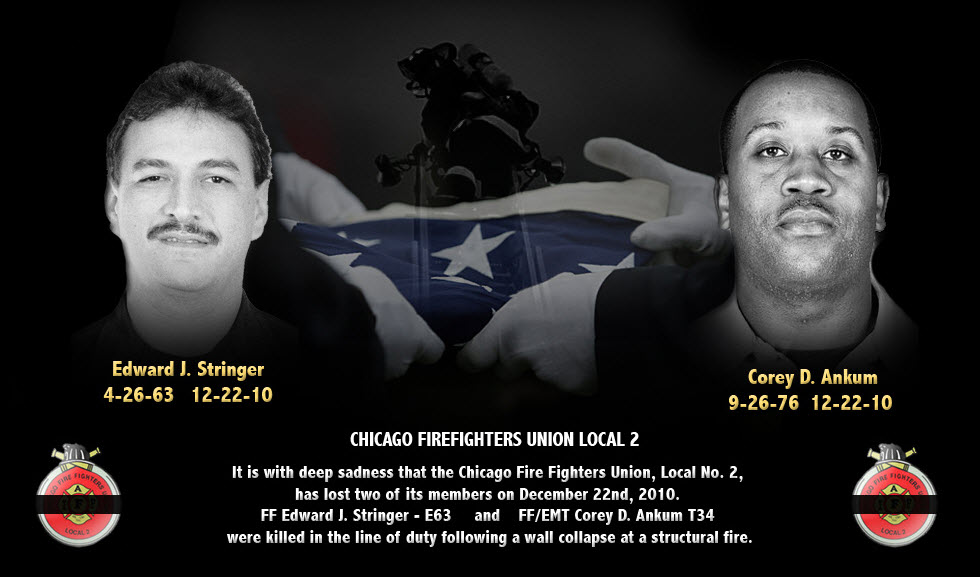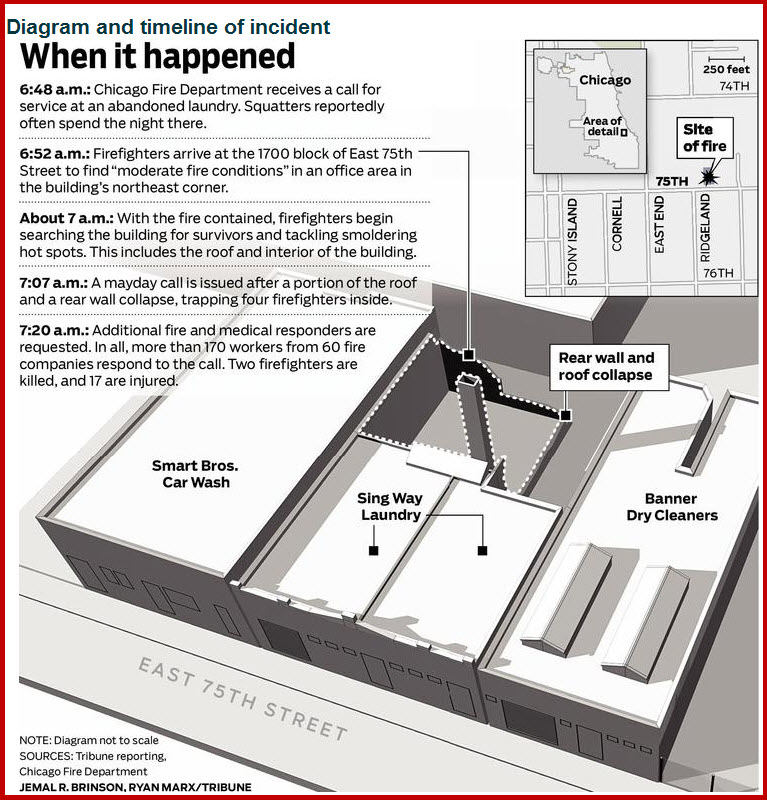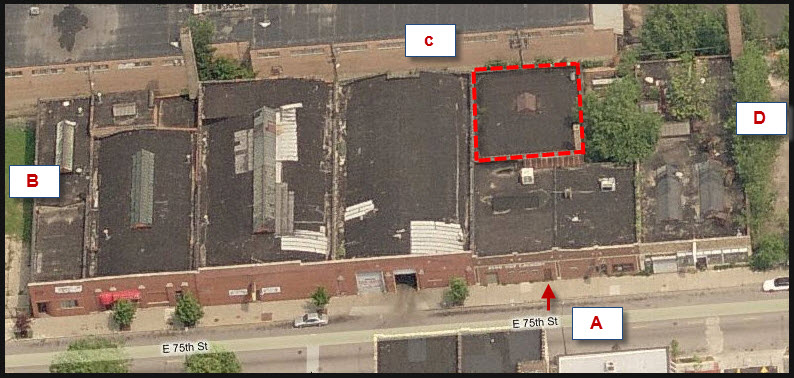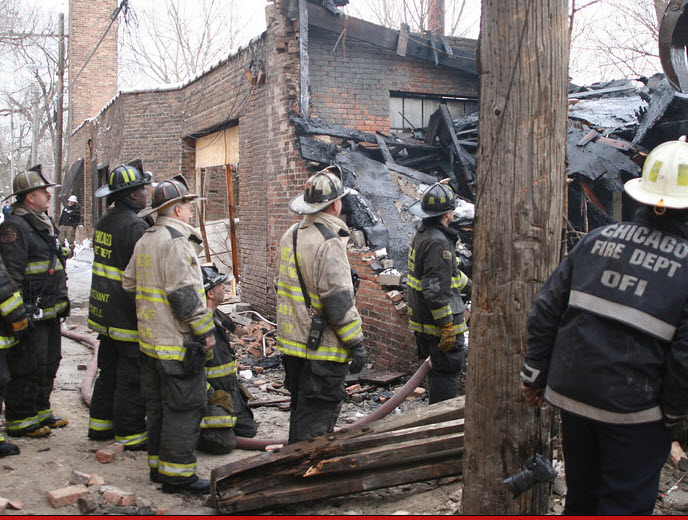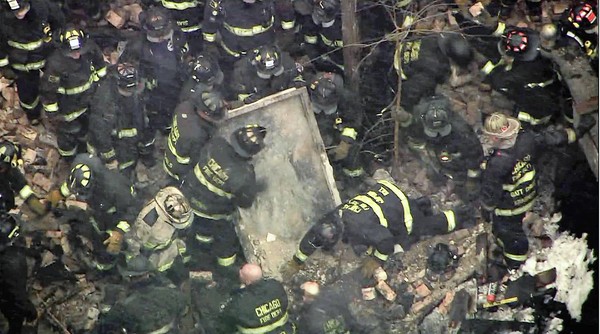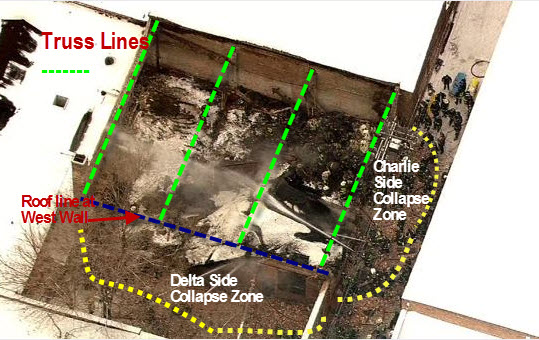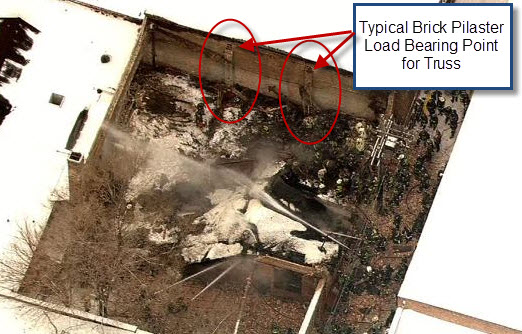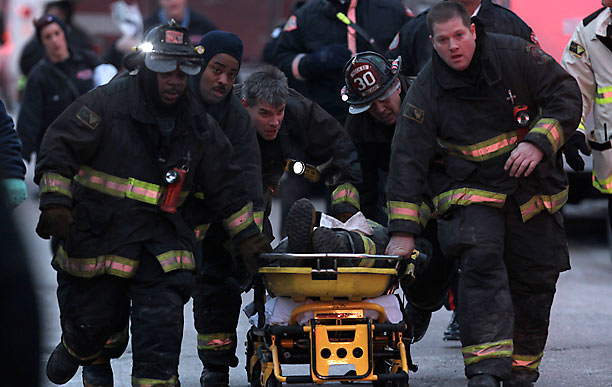Chicago: Anatomy of a Building and its Collapse
By Christopher J. Naum, SFPE on Dec 27, 2010 with Comments 0
The tragic events in the City of Chicago on Wednesday December 22, 2010, when Chicago Firefighter Edward J. Stringer – Engine Co.63 and Firefighter/EMT Corey D. Ankum, Truck Co.34 were killed in the line of duty while operating at a structure fire in an abandoned one-story brick building in the 1700 block of East 75th Street on the City’s South side, exemplifies the demands, challenges and sacrifice that come with responsibilities, duty and sworn obligation that distinguishes the honorable profession of being a firefighter.
The fire was first reported at about 06:48 hours during the night and day tour shift change, with companies arriving at 06:52 hours reporting moderate fire in the buildings northeast corner. The single story commercial structure was vacant, however it was readily known that squatters were known to seek shelter in the abandoned structure especially give the harsh weather being experienced in the city. The fire was quickly contained at approximately 07:00 hours according to published reports, and radio communications, with coordinated suppression, search and rescue and ventilation operations being conduction by companied both within the interior and on the roof.
It was during this phase of operations that a mayday was rapidly communicated at 07:07 hours after a portion of the roof and rear masonry wall unexpectedly collapsed sending personnel operating on the roof riding down with the collapse and trapping four firefighters within the confines of the interior voids. RIT was immediately deployed at the scene for the trapped personnel with reports of numerous firefighters injured by the collapsing wall into the alley way on the Charlie side.
The incident escalated quickly to a 3-11 alarm with subsequent manpower and resources dispatched to provide immediate collapse search, rescue, extrication, medical treatment and incident scene management and support. The resulting structural collapse killed firefighters Stringer and Ankum and injured seventeen other firefighters.
Previous Incident coverage HERE, HERE, HERE and HERE.
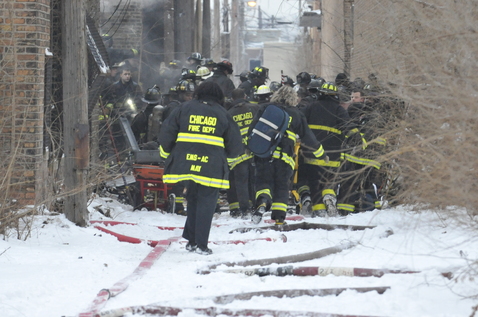
Charlie Side Collapse Zone Rescue Operations Charlie Side transition from Rescue to Suppression Efforts
In this incident the Rules of Structural Fire Engagement were clear and resonated with the commitment and resolve that define the American Fire Service. Companies committed to tactical deployment operations consistent with departmental operating procedures and policy that required interior fire suppression, in conjunction with a coordinated interior search and rescue task assigned, and supported by roof ventilation.
Although the one-story brick building was clearly abandoned and vacant; it was not known if it was unoccupied, thus the tactical search and rescue assignment. According to Chicago Fire Commissioner Robert Hoff, firefighters entered the burning structure because of reports there may have been squatters inside the old laundry and cleaning facility.
By all indications this alarm was a conventional fireground operation being conducted in a fashion consistent with the operating procedures and protocols of the Chicago Fire Department (CFD), executed in a formulative manner that was predicated upon similar past building performance and operations successes. Various news reports and audio recordings of fireground communications identified that first arriving companies recognized the building and occupancy type and were aware that the building had a characteristic bowstring truss roof system in the rear (Charlie side) of the occupancy. CFD procedures dictate identification of the degree of fire involvement or impingement within the truss loft area (concealed or open area located within the open void space of the truss chords between the underdeck of the roof and the bottom chord of the truss) to determine risk and impact on further tactical operational deployment and task assignments.
The CFD is adeptly aware of the historical characteristics, hazards and safety concerns associated with firefighting operations in buildings of bowstring truss construction. The Chicagoland area has an abundance of vintage building types with an array of occupancies that have characteristic small and large span structural bowstring truss systems.
CFD Firefighters know bowstring truss roofs only too well because of the risk of collapse. Twelve years ago, two firefighters died when the bowstring truss roof collapsed on them while fighting a fire in a tire and auto repair shop in Beverly. The roof in the Beverly fire was already ablaze. In the case of 1744 East 75th Street, companies did not identify any fire extension or impingement within the truss loft area during initial phases of deployment and initiated tactical operation assignments accordingly based upon the fire location and strategic incident action plan.
FF Ankum and FF Stringer were killed by the crushing weight of the collapsed roof. With a structural support system comprised of wood timbers configured in a bowstring style truss system, this structural support system and construction style was common in the late 1920s when the building at 75th and Stony Island in South Shore was built.
The truss is arched like a bowstring and provides a clear span within a room or large compartment floor area without intermediate vertical support columns. The structural truss component is typically anchored along the exterior walls where the roof load is transferred to the vertical walls and down to the foundation.
The building and occupancy at 1744 East 75th Street however did have a risk profile not related to its occupancy type and one that was not readily known to operating company or command officers during the initial stages of fireground operations; that this building was in state of disrepair and had received numerous citations and notices of action. The unstable nature of the building, the apparent poor condition of the roof and inherent deficiencies in the structural support system and construction created an operational risk profile that could not be identified readily through conventional size-up by arriving and deploying command or company officers.
It was reported that the city had previously cited the building owner for numerous building code violations; including failing to maintain the roof- which, according to the violation, had holes and was rotted and leaking. The violation also indicated the roof trusses were vented and rotted. It is not known if pre-fire plan information was readily available to responding companies or if recent first-due company level inspections or walk-thru had been initiated or completed.
In an effort to provide timely learning’s from this incident and in advance of the more thorough and detailed subsequent investigative reports and information that will be forthcoming in the months ahead, I’d like to provide some insights and basic information to increase firefighter, company and command officer awareness and knowledge related to the operational concerns for similar buildings with bowstring truss structural roof systems and share some observations related to presumptions deduced from incident scene photos.
The representative insights derived from this incident are in no way meant to analyze or offer criticism towards any element of the operations conducted at 1744 East 75th Street; but are provided to increase your knowledge of building features to support operations at similar structures and occupancies so as to reduce the likelihood of other history repeating events (HRE) in your jurisdiction or response district.
These insights are based upon an analysis of incident scene photographs, internet based images and maps from Google, Bing along with video and audio media clips. Interpretations and assumptions made (especially related to dimensions, size and configurations) are representative to provide content to scale and similarities with other typical construction features in an effort to advance knowledge.
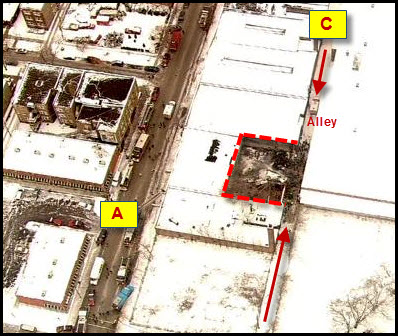
Aerial Photo of the Collapse Zone looking from the Delta Side. The Rear Alleyway on the Charlie Side runs parallel to East 75th Street
Anatomy of the Building and Collapse
The structure at 1744 East 75th Street appears to have been part of a larger series of collective occupancies and structures that previously spanned the entire city block, sharing construction features and commonalities consistent with construction methodologies and practices in the 1920’s through the 1940’s. An aerial view of the 1700 block of East 75th Street clearly shows the series of one-story brick buildings sharing both common party walls and possibly independent bearing walls between separate occupancies, with their distinctive roof profiles and varying square footage of floor area.
The Alpha [A] side is East 75th Street with a common parallel alleyway located on the Charlie [C] side. The collapse area appears to have been approximately a 60 feet (depth) x 50 feet (width) for an area of ~ 3000 square feet. Published reports indicated the roof system present in the immediate collapse zone was comprised of bowstring truss components.
This is evident in a series of fireground photos that clearly depict the remnants of a shallow depth built-up chord bowstring truss comprised of timber wood components.
It appears the bowstring wood truss components rested on top a series of four (4) brick wall pilasters and pocketed within the east and west brick bearing walls. The north non-bearing brick wall appears to be a three wythe solid brick wall, with the bearing walls running east-west. The non-bearing brick wall running parallel to the alley way was the portion of wall that collapsed outward as a result of the inward collapse of the truss roof support system, wood rafters and plank roof deck.
The inward momentum created by the downward forces of the failing roof area, pushed outward the entire north wall face, which based upon the modular characteristics of the brick and mortar, most likely caused the wall to collapse in sizeable sections (outward collapse as well as disintegrate into smaller projectiles with a classical curtain failure. Photos suggest the wall failure resulted in a collapse zone that spanned the entire narrow alley way from wall to wall (estimated at 18 +/- feet) leaving no room to escape the lateral failing wall collapse without running in an east and west direction only.
The single story size of this common Type (Class) III Ordinary Construction building which is estimated at 18 feet in height appears to have had a parapet wall raising above the roof line, consistent with design features found in buildings of this vintage.
The single story height coupled with the square foot floor/roof area, any loss of structural integrity of a single truss component would likely cause the compromise or collapse of adjacent truss components and connective decking planks due to the interdependence and connectivity of the roofing support (trusses), purlins, rafters and roofing planks and outer membrane system.
- Typically the failure of one bowstring truss span will compromise or cause the collapse of each adjacent truss to either side of the original affected truss causing the failure of a sizeable roof area.
- Companies operating on such affected roof area areas are subject to high risk and vulnerability should the roof area fail. Refer to the incident conditions and structural collapse from the Waldbaum’s Collapse, FDNY August 2, 1978. Go to the incident overview at Commandsafety.com HERE.
- In smaller square foot commercial occupancies that have shallow depth bowstring truss components and both limited spans (less than 100 linear feet clears span) and numbers of truss (six or less) the likelihood of a catastrophic roof collapse should be considered highly predicable in all incident action plans and incident status monitoring.
- The loss of load bearing and load transfer capabilities at the wall connect create can contribute towards failure and collapse conditions. The end connections points of a bowstring truss are critical towards maintain truss performance and structural integrity.
- The loss of truss axial orientation, excessive deflection, integrity of chord/ web geometry and connection points can lead to failure mechanisms and a cascading effect due to transferring of loads and possible overstressing and subsequent failures.
Photo examination further identifies the presence of concrete masonry units (CMU) evident in a number of incident scene images that suggests renovations and alterations at some point in the building’s recent history that may have had an impact on the buildings integrity or performance profile ( postulated, actual or forecasted).
- It should be noted that fire service personnel should have a high degree of respect for the danger and susceptible risk imposed by compromised or failing bearing and non-load bearing walls.
- Collapse zones must be established and access controlled based upon physical incident scene layout, access and proximal exposure structures.
- All fire service personnel should have awareness level training and an understanding of recognizing collapse indicators for buildings of masonry construction and tactical safety considerations
- Company and Command Officers must have a higher level of knowledge and training to be able to recognize subtle of obvious construction, conditions or indicators that will affect IAP, strategic, tactical or task assignments and be able to act upon those indicators with immediacy and urgency as conditions and risk dictate.
- The Collapse Zone should be at a minimum be equal to the full height of the exterior masonry wall face and also take into consideration additional distance due building material momentum, bounce and toss due to individual bricks, steel lintels and other components and materials acting as projectiles and traveling distances greater than the defined “collapse zone”.
- The sheer weight and mass present in a brick wall presents significant probability of debilitating injuries and death if caught in the collapse zone by falling wall sections or brick projectiles.
- A standard common brick may weight 4.5 – 6 lbs. each. An 8 inch wide brick wall may weigh upwards of 83 pounds per square foot (PSF).
- For illustration purpose; A 50 foot long wall x 18 feet in height constructed with a solid 8 inch wide brick non-load bearing wall (assuming 15% openings for doors/windows) would have an estimated dead load weight of 63,500 lbs. (31.75 ton)
- Fire Service personnel must be aware of the three common exterior masonry wall mechanisms of collapse that include; outward monolithic wall collapse, inward/outward wall collapse and curtain fall collapse. Building height, width (wyth) of the wall, bearing or non-bearing wall types, weather conditions, fire impingement or exposure and age, reinforcement, deterioration/integrity of mortar joints etc., all have influencing effects on the actual manner in which an exterior masonry wall will collapse.
- In smaller single story commercial structures of Ordinary Type III construction, the 90-degree monolithic and/or curtain-fall wall collapse can be expected.
- The probability of void spaces being present due to a catastrophic collapse of a bowstring truss roof system are predicated upon the presence of interior space features such as shelving, equipment, products/materials and any small height area partitions or physical barriers (that may even extend upwards to the understructure of the truss chord) and the manner in which the structural bowstring truss component and integrated roofing system fail or compromise from the outer wall bearing points. (pancake, lean-to)
- The collapse of the roofing deck system resulting from a compromise or collapse of the bowstring truss system may cause under some circumstances a longitudinal failure or cracking of the upper masonry wall either along the line of the roof/parapet interface or in an area immediately beneath this point.
- The resulting impact due to dynamic load transfers may cause the upper masonry wall and/or parapet to collapse inward while simultaneously causing the lower masonry wall section to collapse in an outward manner into the exterior collapse zone.
- The manner in which the exertion of force applied to the outer masonry wall during the mechanism of the collapsing of the roofing system will determine the extent of force, failure and degree of brick material that will be deposited at the base of the wall and beyond within the collapse zone.
- Refer to the following NIOSH LODD Reports related to brick wall or component & collapses;
- Brick Parapet Wall Collapse: http://www.cdc.gov/niosh/fire/reports/face200821.html
- Brick Chimney Collapse: http://www.cdc.gov/niosh/fire/reports/face9906.html
Built-up bowstring trusses such as the ones that appear to have been present at 1744 East 75th Street came in varies sizes related to the dimension of the structural wood components utilized (heavy timber or built-up), the depth of truss related to its span and its load bearing design/capacity (and the subsequent truss loft void created by the truss top and bottom chord as well as the manner in which the truss web members were held together, the connection methods utilized and the manner in which the truss component was designed to be seated in its load bearing position (pocketed or surface load bearing).
The following photographs provides a representative example of a heavy timber truss showing the steel U-shaped end shoe (bolted to the bottom chord) seated on the bearing plate of the pilaster. This is a common connection point and is a critical area for maintaining the structural integrity and stability of the roof system.
These load bearing points are susceptible to age related deterioration of the bearing surface, shoe connection/chord connection, loss or degradation of the bearing wall conditions, decay or deterioration of the end connections that adversely affect the structural stability of the top truss cord to transfer the thrust loads imposed upon this connection into the bottom chord.
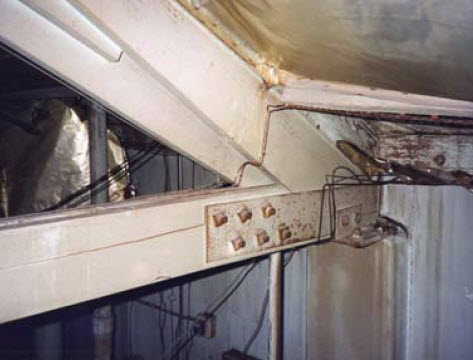
Typical Truss End with Bottom Chord, Steel End Shoe and Load Bearing Plate on a Pilaster. Note the crack in the bottom wood cord running from the steel shoe and bolt connections; an area of concern
A bowing or outward thrust of brickwork on a visible exterior bearing wall is a clear indication that deterioration has occurred and that the structural stability of the wall roof system is in question as well as the stability to conduct safe tactical interior or roof operations by fire service personnel.
- Other age related conditions affecting bowstring truss stability include creep deformation, stressed, loosened or damaged connection points due to imposed loads over many decades, the effects on longer deflection under load, the effects or wood shrinkage and drying affecting the geometry and thus strength and stability of the truss, along with a higher potential for structural failure and collapse.
These conditions can all be exasperated by fire, heat impingement or contact as well as long term imposing dead loads of the roofing system(s) and more importantly live loads such as rain or snow accumulation (as well as concentrated live loads) or the placement of fire personnel to conduct tactical roof assignments.
Published research and test results has also have shown that in many instances heritage vintage truss systems such as the bowstring truss (circa 1880-1950) were designed in a manner that did not take into account conservative bottom cord tensile strength design. Most trusses from this time frame were not designed under the same criteria implemented in today’s building codes and specifications and thus are prone to compromise and failure under a variety of both fire and non-fire induced incident scenarios.
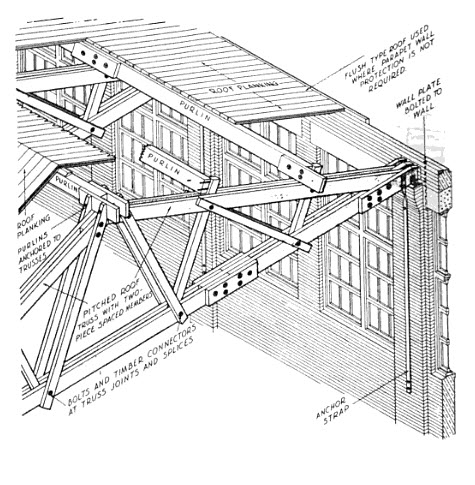
Representative Construction Cut Away of A Heavy Timber Gable Truss roof and Pilaster with content to te Bowstring Truss System Typical Bowstring Roof Truss Configuration and Span with No Concealed Truss Loft
Another key observation point during operational assessment and size-up includes the observation of any excessive truss chord sag along the span, rot, deterioration, cracked or split chords, splices, web members of visible end connections. The identification of such conditions during any phases of operations should be promptly evaluated as a pronounced high risk to personnel safety and further operational integrity. In other words; it time to immediately reconsider risk, strategic and tactical operational objectives and the likelihood for isolated structural compromise or catastrophic structural collapse.
The following video clips provide good examples of the extent, physical force and collective momentum of mass that a collapsing section of brick wall can inflict as it fails. These video clips represent multi-floor collapse and variable larger collapse zones on grade and within the immediate operating areas.
Other Insights and Considerations
- During all operations involving actual or suspected Bowstring Truss Roofing Support Systems Command and Company Officers should be sensitive to risk assessment indicators related to both fire induced conditions as well as environmental and age induced factors.
- Pre-plan your buildings look at the construction, components, features and condition of the building; there is a tremendous amount of information out there. Understand and comprehend what to look for, what it is that you’re looking at and more importantly make sure the information is retrievable for on-scene application and that the information is utilized when formulating IAP and in the dynamic risk assessment process
- During Dynamic Risk Assessment, special attention should be focused on Predicated Building Performance common to identified building systems, features and structural systems that are based upon Occupancy Performance and NOT Occupancy Type.
- The Federal Emergency Management Agency’s (FEMA) United States Fire Administration (USFA) issued a special report examining the characteristics of fires in vacant residential buildings. The report, Vacant Residential Building Fires, was developed by USFA’s National Fire Data Center and provides useful insights and recommendations. Link HERE
- When developing incident action plans and operational assignments at incidents involving possible Vacant, Unoccupied or Abandoned structures, command and company officers shall implement a formulative risk -benefit assessment consistent with departmental procedures, policies and expectations.
- Be knowledgeable of operational factors and considerations related to operations at Vacant, Unoccupied or Abandoned structures; HERE and HERE
- Read the Newest NIOSH Alert: Preventing Deaths and Injuries of Fire Fighters at Structure Fires, HERE
- Start considering building; age, deterioration, environmental impacts and influences in your IAP and tactical considerations, we at times forget to consider these performance indicators effectively during initial or sustained operations.
- Learn more about Building Construction, Occupancy Profiling, Reading a Building, Occupancy Risk versus Occupancy Type and always consider Tactical Patience.
- Increase your knowledge on Structural Collapse indicators especially for buildings of masonry construction in both Type III and Type IV construction.
- There is a Predictability of Performance in all Buildings and Occupancies with Heavy Timber or Built-up Bowstring Truss Structural Systems; Know what they are.
- Understand what to look for in Heavy Timber or Built-up Bowstring Truss Structural System integrity related to; Age and Deterioration, Gravity, Cross Grain Shrinkage, Wood Defects that are self-evident in chords and web members, Upper Chord Buckling, Lower Chord splitting or failure points, web splitting or pull-outs, multiple roofing systems or membranes, multiple void spaces, compromised bearing walls or pilasters, compromised or degraded bearing points or truss ends.
- Learn to identify masonry wall features and what they mean towards tactical operations
These are some immediate considerations for increasing operational integrity while maintaining firefighter safety and does not reflect the full extent of safety or operational considerations that must be imposed and implemented at operations involving buildings of Type III or IV construction or those with bowstring truss components; but it is a stepping stone and for many, the first exposure to this type of information.
Remember; Building Knowledge = Firefighter Safety
Other Links
- Roof of building in deadly fire called ‘defective’ in 2007, Link HERE
- A fire commissioner’s words on tragedy, tempered by his family history, HERE
- Chicago Tribune Editorial: ”Every fireman knows”, a must read….HERE
- Operational Safety Training Aide: Ordinary and Heavy Timber Constructed Occupancies Training Download from Commandsafety.com
- Lessons Learned: Buffalo, NY Three Alarm Fire and Double LODD Report
- San Francisco: Collapse of Bowstring Truss Roof Seriously Injures Fire Fighter
- FDNY: The Waldbaum Fire Collapse FDNY 1978 Remembrance
- Ordinary Construction Floor Collapse: http://www.cdc.gov/niosh/fire/reports/face200923.html
- Brick Parapet Wall Collapse: http://www.cdc.gov/niosh/fire/reports/face200821.html
- Partial Roof Collapse: http://www.cdc.gov/niosh/fire/reports/face200509.html
- Roof Collapse during interior operations: http://www.cdc.gov/niosh/fire/reports/face9617.html
- Trapped during fire suppression operations at a millwork facility: http://www.cdc.gov/niosh/fire/reports/face200807.html
- Don’t forget o research some of the Near Miss Reports on the NFFNMRS: http://www.firefighternearmiss.com/
Filed Under: Anatomy of Buildings • BuildingsonFire • Combat Fire Engagement • The Collapse Zone
